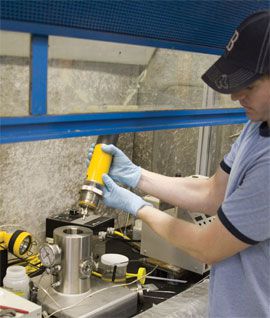Waterlogged wood artifacts may be rescued by technological advances in drying techniques
Betty Seifert at the Maryland Archaeological Conservation Laboratory
When Union ships sunk the English blockade runner Modern Greece off the coast of North Carolina in 1862, Confederates at nearby Fort Fisher wasted little time in salvaging munitions from the vessel. Nearly 150 years later, what they left behind is helping make history in preservation research.
Gunstocks from the shipwreck were used in NCPTT-funded research by the Mariners’ Museum in Newport News, Va. to investigate the use of emerging technologies to dry waterlogged archeological wood.
“Waterlogged wood collapses and shrinks when exposed to air, potentially destroying significant archeological data,” Eric Schindelholz, the project’s principal investigator, said. “We studied a method called supercritical drying, which does not add chemicals to the wood that could affect its long-term preservation and the reversibility of the treatment.”

Jason Hemmer, graduate student at Clemson University, examines the supercritical reactor and impeller head used for the study.
(Photo Credit: Uknown)
Researchers at St. Andrews University developed the supercritical drying technique in the 1990s and the method promises to reduce treatment time from months, as with current methods, to days.
Supercritical fluid is created by compressing a gas or a liquid at elevated temperatures. The resulting product is neither liquid nor gas and its lack of surface tension prevents pressure damage to the weakened wood. A similar method is used in “green” dry cleaning and in decaffeinating coffee.
The supercritical drying method involves replacing the water in the wood, which will not mix with supercritical carbon dioxide, with methanol, which will mix in supercritical carbon dioxide. The methanol in the wood is replaced with the carbon dioxide in a pressure chamber. The chamber is then decompressed and the carbon dioxide escapes from the wood leaving a dry specimen.
Researchers compared the physical effects of supercritical drying on the wood to air-drying and the popular freeze-drying method. They had plenty of material with which to work. The gunstocks from the Modern Greece were among hundreds of artifacts in submerged containment at the North Carolina Underwater Archeology Branch. Additionally, researchers studied samples from an unidentified shipwreck in Maryland.
The samples were measured using pins inset in the samples and by 3-D laser scanning before and after treatment to measure shrinkage. The microscopic effects of each treatment were evaluated as well.
“We found the supercritical drying was successful in someÐbut not all Ðof the wood samples,” Schindelholz said. “This project did confirm the potential of this process and has laid the necessary groundwork from which to scale up the supercritical drying technique for use on larger archeological artifacts.”
The study also confirmed the efficacy of freeze drying for preventing collapse and shrinkage in the wood.
The Mariners’ Museum partnered with the National Oceanic and Atmospheric Administration, Old Dominion University, Clemson University, University of Minnesota, Maryland Trust and the NPS Harpers Ferry Center.

